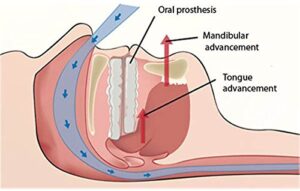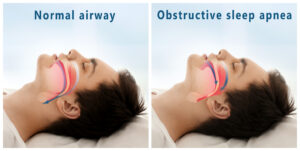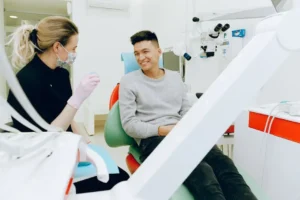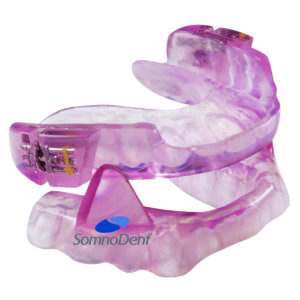
A sleep apnea mouth splint helps keep your airway open during sleep, reducing interruptions and improving sleep quality. This article will explain how these splints work, their benefits, types, and key considerations.
Key Takeaways
- Sleep apnea mouth splints are effective in maintaining an open airway by repositioning the jaw or tongue, enhancing airflow, and improving sleep quality.
- There are two primary types of mouth splints: Mandibular Advancement Devices (MADs) and Tongue-Retaining Devices (TRDs), each catering to different patient needs based on comfort and dental conditions.
- While mouth splints offer significant benefits such as comfort and improved sleep quality, potential side effects include jaw discomfort and dental alignment issues, necessitating regular check-ups with a healthcare provider.
How Sleep Apnea Mouth Splints Work
 Sleep apnea mouth splints, often referred to as oral appliances, are designed to tackle obstructive sleep apnea by maintaining an open airway during sleep. But how exactly do they accomplish this? The primary function of these devices is to reposition either the lower jaw or the tongue to prevent airway collapse. These appliances enhance airflow by keeping the airway unobstructed, reducing breathing interruptions, and significantly improving sleep quality through oral appliance therapy.
Sleep apnea mouth splints, often referred to as oral appliances, are designed to tackle obstructive sleep apnea by maintaining an open airway during sleep. But how exactly do they accomplish this? The primary function of these devices is to reposition either the lower jaw or the tongue to prevent airway collapse. These appliances enhance airflow by keeping the airway unobstructed, reducing breathing interruptions, and significantly improving sleep quality through oral appliance therapy.
Wearing a sleep apnea mouth splint gently shifts the lower jaw or holds the tongue in place to prevent throat muscles from collapsing and blocking the airway. This repositioning ensures easier breathing throughout the night. The result is not only fewer interruptions but also deeper, more restorative sleep, which can have a profound impact on your overall health and well-being.
Think of it this way: a sleep apnea mouth guard acts like a night-time guardian, vigilantly keeping your airway open so you can enjoy uninterrupted slumber. For many, sleep apnea mouth guards can be a game-changer, providing a much-needed break from the relentless cycle of disrupted sleep.
Types of Sleep Apnea Mouth Splints
There are two main types of sleep apnea mouth splints. These are Mandibular Advancement Devices (MADs) and Tongue-Retaining Devices (TRDs). Each type has its unique mechanism and benefits, making them suitable for different patient needs and preferences.
Mandibular Advancement Devices (MADs) are the most commonly used oral appliances for treating obstructive sleep apnea. They work by moving the lower jaw forward to keep the upper airway open, significantly improving airflow and reducing breathing interruptions.
On the other hand, Tongue-Retaining Devices (TRDs) use suction to hold the tongue in a forward position, which helps maintain an open airway, especially for individuals who cannot use MADs due to insufficient dental support. Let’s delve deeper into each type.
Mandibular Advancement Devices (MADs)
Mandibular Advancement Devices (MADs) are ingeniously designed to move the lower jaw forward, thereby keeping the airway open and reducing the risk of airway collapse during sleep. These devices come in various designs, including single-piece and two-piece models. The two-piece models offer more flexibility and allow for greater mouth movement, making them more comfortable for many users.
Custom-made MADs are particularly effective for treating sleep apnea, as they are tailored to fit the user’s dental arches precisely. This custom fit ensures that the device remains in place throughout the night, providing consistent results. Compared to over-the-counter options, custom MADs significantly improve airflow and offer better long-term control of sleep-disordered breathing, including appliances for sleep apnea.
For those dealing with mild to moderate obstructive sleep apnea, MADs can be a highly effective solution. By gently repositioning the lower jaw, these devices help maintain an open airway, reduce snoring, and improve the overall quality of sleep. Patients often find them to be a comfortable and less intrusive alternative to CPAP machines, leading to higher compliance and better treatment outcomes. Additionally, obstructive sleep apnea OSA can significantly impact overall health, making it essential to treat obstructive sleep apnea effectively.
Tongue-Retaining Devices (TRDs)
Tongue-Retaining Devices (TRDs) offer a unique approach to treating obstructive sleep apnea by focusing on the position of the tongue. These devices use suction to keep the tongue in a forward position, which helps to maintain an open airway throughout the night. This is particularly beneficial for individuals who may not have enough teeth to support a mandibular advancement device (MAD) or who find MADs uncomfortable.
TRDs can be a suitable alternative for those who cannot use MADs due to dental issues or other considerations. By preventing the tongue from falling back and obstructing the airway, TRDs can significantly reduce breathing interruptions and improve sleep quality.
However, it’s important to consult with a sleep specialist to determine which type of device is best suited for your specific needs.
Advantages of Using a Sleep Apnea Mouth Splint

Another significant benefit is the improvement in sleep quality. By reducing breathing interruptions, sleep apnea mouth splints help you achieve deeper, more restorative sleep. This can lead to higher blood oxygen levels, reduced daytime sleepiness, and an overall better quality of life. For those who have struggled with the relentless fatigue associated with sleep apnea, the difference can be nothing short of transformative.
Additionally, sleep apnea mouth splints significantly decrease symptoms like snoring and excessive sleepiness. This not only benefits the user but also their sleeping partner, leading to more harmonious household dynamics. Higher treatment adherence, coupled with improved sleep quality, makes these devices a highly effective solution for many obstructive sleep apnea patients.
Potential Drawbacks and Side Effects
Mouth splints for sleep apnea provide various advantages. However, they also have potential drawbacks and side effects. Common side effects include jaw discomfort, teeth and gum irritation, dry mouth, and excessive saliva production. These issues are usually temporary and tend to diminish as the user becomes accustomed to wearing the appliance.
However, there are some long-term considerations to keep in mind. Prolonged use of a sleep apnea mouth splint can lead to changes in dental alignment and muscle issues in the jaw. Regular check-ups with your dentist are necessary to monitor for these potential complications and make any needed adjustments to the device.
Many users find that the benefits far outweigh the side effects despite these drawbacks. Proper fitting and regular adjustments can minimize most discomfort, allowing you to fully benefit from improved sleep quality and reduced sleep apnea symptoms.
Effectiveness of Sleep Apnea Mouth Splints

Studies have shown that the treatment outcomes of mandibular advancement splints (MAS) can be comparable to continuous positive airway pressure therapy, especially in terms of improving quality of life and reducing blood pressure. While CPAP machines are generally more effective at minimizing breathing pauses, many patients prefer the comfort and convenience of sleep apnea mouth splints, which can lead to higher compliance rates.
However, it’s important to note that certain factors, such as body mass index (BMI), can influence the effectiveness of these devices. Patients with a higher BMI may experience less favorable outcomes. Therefore, working closely with your healthcare provider ensures that the treatment plan is tailored to your specific needs and circumstances.
Who Should Consider a Sleep Apnea Mouth Splint?
Sleep apnea mouth splints are particularly beneficial for individuals with mild to moderate obstructive sleep apnea. These devices are ideal for those who find CPAP machines uncomfortable or cumbersome and are seeking a less intrusive treatment option. If you’ve struggled with CPAP therapy, a sleep apnea mouth splint might be the solution you’ve been looking for.
Younger adults tend to experience greater benefits from mandibular advancement device therapy. This is also true for women with a lower body mass index. This makes them excellent candidates for this type of treatment. Additionally, individuals who are looking for a non-invasive, comfortable alternative to traditional treatments will find sleep apnea mouth splints to be a suitable option.
Consulting with a sleep specialist will help determine whether a sleep apnea mouth splint is the right choice for you. A thorough evaluation and diagnosis are essential to ensure that you receive the most effective treatment for your specific condition.
Getting Fitted for a Custom Sleep Apnea Mouth Splint

After diagnosis, the next step is to see a qualified dentist. They will either take an impression of your teeth or produce a 3D scan. This impression or scan is then sent to a manufacturer to create a custom-fitted mouth splint designed to fit your dental arches precisely. The fitting process includes assessing how your teeth bite together to ensure the device is comfortable and effective.
Follow-up appointments are crucial after receiving your custom device to make any necessary adjustments. Monitoring the performance of the mouth splint and ensuring optimal results requires a multidisciplinary approach involving both a sleep physician and a dental practitioner.
Maintaining and Caring for Your Sleep Apnea Mouth Splint
Proper maintenance and care ensure the longevity and effectiveness of your sleep apnea mouth splint. Daily cleaning, starting with brushing the device using a soft-bristle toothbrush without toothpaste, is recommended. This helps to remove bacteria and prevent odor buildup.
Before:
Rinsing the mouth guard thoroughly before each use is also important to eliminate any food particles that may be present. In addition to daily cleaning, soaking your mouth guard in a denture cleaning solution weekly disinfects it. This practice helps to maintain the hygiene of the device and prevents bacterial growth.
After:
- Rinse the mouth guard thoroughly before each use to eliminate any food particles that may be present.
- Soak your mouth guard in a denture cleaning solution weekly to disinfect it.
- Maintain the hygiene of the device to prevent bacterial growth.
After cleaning, always allow the mouth guard to air dry before storing it in its case. Following these recommended cleaning and storage practices ensures your sleep apnea mouth splint remains in good condition and continues to provide effective treatment.
Monitoring Progress and Adjusting Treatment
Monitoring your progress and adjusting your treatment plan are crucial for successful sleep apnea management. Regular follow-ups with your healthcare provider are important. This ensures that the device remains effective and comfortable. These appointments allow for necessary adjustments to the mouth guard to optimize its performance.
Tracking symptom improvements and any new issues is essential. Follow-up sleep tests may be required to determine the effectiveness of the oral appliance. Repeat sleep studies are often recommended to assess treatment efficacy after making device adjustments.
Constant communication with your dentist and sleep physician keeps your treatment on track and ensures desired results. By staying proactive and engaged in your treatment plan, you can achieve better sleep quality and overall health.
Summary
Sleep apnea mouth splints offer a comfortable, effective alternative to traditional CPAP therapy for many individuals suffering from obstructive sleep apnea. These devices work by keeping the airway open during sleep, significantly improving airflow and reducing breathing interruptions. With various types available, including Mandibular Advancement Devices (MADs) and Tongue-Retaining Devices (TRDs), there is a suitable option for almost every patient.
By understanding the benefits, potential drawbacks, and proper maintenance of sleep apnea mouth splints, you can make an informed decision about your treatment. Remember, quality sleep is not a luxury—it’s a necessity. Embrace the journey towards better sleep and improved health with the help of a sleep apnea mouth splint.
Frequently Asked Questions
How do sleep apnea mouth splints work?
Sleep apnea mouth splints effectively reposition the lower jaw or tongue to maintain an open airway during sleep, which enhances airflow and minimizes breathing interruptions.
Who should consider using a sleep apnea mouth splint?
Individuals with mild to moderate obstructive sleep apnea or those who find CPAP machines challenging to use should consider a sleep apnea mouth splint. This device can provide an effective alternative for managing their condition.
What are the common side effects of using a sleep apnea mouth splint?
Common side effects of using a sleep apnea mouth splint include jaw discomfort, gum irritation, dry mouth, and excessive saliva production. Typically, these side effects decrease as the user becomes more accustomed to the device.
How effective are sleep apnea mouth splints compared to CPAP machines?
Sleep apnea mouth splints can be as effective as CPAP machines in improving sleep quality and reducing symptoms such as snoring and daytime sleepiness, though CPAP machines tend to be more effective at minimizing breathing pauses. Ultimately, the choice between treatment options will depend on individual needs and preferences.
How do I maintain and care for my sleep apnea mouth splint?
To maintain your sleep apnea mouth splint, it is essential to clean it daily with a soft-bristle toothbrush, soak it weekly in a denture cleaning solution, and allow it to air dry. Following these practices will help ensure the splint remains in good condition.

